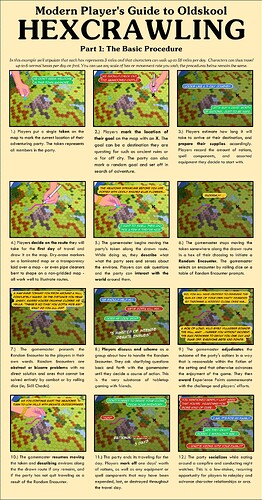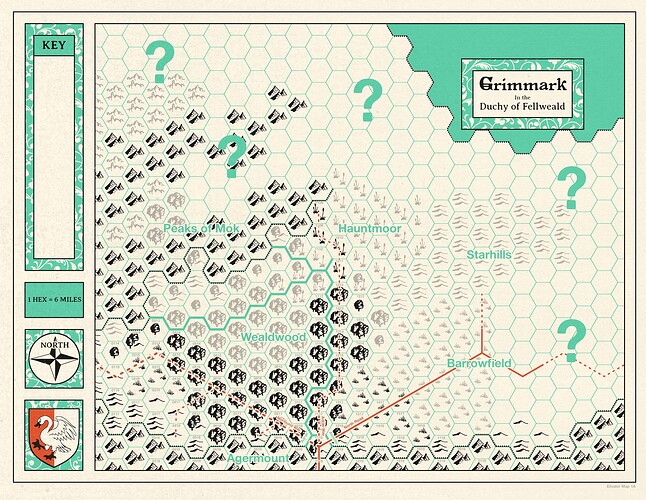I found this image on Reddit and the author gave me permission to share it around, as there is no other place people might find it.
A question for experienced hexcrawlers: do you always treat the map as totally reliable? There’s all sorts of examples from our world of cartographic errors both subtle and not-so-subtle (e.g. Mountains of Kong) which could provide interesting twists. Perhaps the map you bought from the shady man in the tavern does indeed show the location of a forgotten temple, but maybe he missed out the snarled forest in between or the kilometre-wide river, and so the players are caught unprepared.
Or does introducing imperfect maps just cause player frustration/ constant second-guessing about map authenticity?
I’ve had experience both ways. When Austin ran bar hak ( a homebrew lotfp west marches campaign) he refused to provide us with reliable maps. Everything had to be mapped by us. Or we would find maps but thru proportions were all different scales and things were represented in different ways. It was awesome in that we felt like the world was very real. It was also frustrating in that we often felt lost or at least lost adjacent. As travelled more and connected things with actual travelled distances and cleared and strengthened pathways it started to feel more reliable but it was still a lot of work to safely traverse into any new areas. Going off the path was dangerous. I’ve also played in games where the hex map was provided and travel was more routine, not safe per se but at least a known quantity. It felt stable and reliable and there was a charm to being able to plan routes and setup travel with distances known and directions assured. It also very much felt like the world was a known place and like the map was the territory. So not high on the verisimilitude. I should also mention I’ve usually been the mapper for my online games on account of my tablet and drawing programs, so I’m usually exploring the right way to map something if a map isn’t presented.
So this guide is pretty unconventional, as its rare to ever show the players a hexmap (unless you have them track their own hexes).
The hexmap generally isn’t an in-fiction artifact, its an abstraction for the referee to use to help keep track of location and manage a few procedures.
I often provide players with in-fiction maps which are always imperfect, as that makes the most sense to me, provides fun, and keeps me from needing to be a skilled artist or cartographer.
I’ve always provided the players with a hex map, believing it would simplify things for me. The idea was that they could use the map to determine their position, plan routes, and even estimate travel durations without me having to do all the calculations behind the scenes. In practice, however, it’s a mixed bag. I’ve noticed that the players have much better sense where they are in the world when they use the hex map, although I still need to calculate travel times most of the time myself. Without a hex map, they tend to get lost, which means I end up constantly reminding them of their location.
I previously used a non-hex, region-focused map, but that left the players confused most of the time as well. Now, hearing you using multiple in-fiction maps, I believe this could work pretty well. I have to include more local maps. That sounds fun and is a good prop as well. The occasionally treasure map is always a hit. Perhaps I’ll try this approach once I find the time to create some maps.
I enjoy using player-facing hex maps, much like this image outlines. (The main difference is I break up travel time into watches instead of travel days.) A player-faving hex map definitely makes travel feel a little board-game-y, but we don’t mind it—it’s fun! Hexes whose contents they’ve heard of or seen on an in-world map are faded out, only to be fully solidified once visited and their validity confirmed.
(Edit: this map is missing POIs and the map key because those are added in our VTT)
I’m excited to try Hexcrawling for the first time in a new OSE game I’m starting later this month. My plan is to give the players a hand-drawn in-world map with some key locations and then give them a mostly blank hex map with only their starting area and adjacent hexes detailed. The idea being that players will have a general idea of how to get to some notable location since they have the in-world map, but they won’t know how far away it is nor precisely what lies in between.
I can also use NPCs in the setting update the in-world map with additional locations (“let me add that to your map…”)
for me, if you are doing a hex crawl, its BETTER with a player facing hex map. it feels more boardgamey, but I dunno, somehow more satisfying too? I guess its just an affectation of play that, once you accept it, it kinda gets out of the way and you get back into immersion.
the way it feels to me is that the hex map is a sorta key to the imagined world. like, it doesn’t exist in that world, but its the connection to it.
my ultimate preference is for a plain map, with only say, a miles scale to it. then have the GM have point crawl bones behind it. but you know, the same way I prefer say, one cuisine over another. they are all good! I just have a current preference that I may change at any moment.
I guess a player-facing hex map is kind of just like a character sheet for the world
a thousand nods of agreement.
i always think of the actual characters existing on the other side of the character sheet. like, nebulously in a fictional realm that you can barely catch a glimpse of. you flip the sheet, and its just paper, and that wisp of the actual character is gone.
so yea, hexmap. same deal. its NOT THE ACTUAL FICTIONAL WORLD. but its the abstraction of that world that we can see and touch. and just behind it… if you could just tear the map correctly… thats where the world is.

